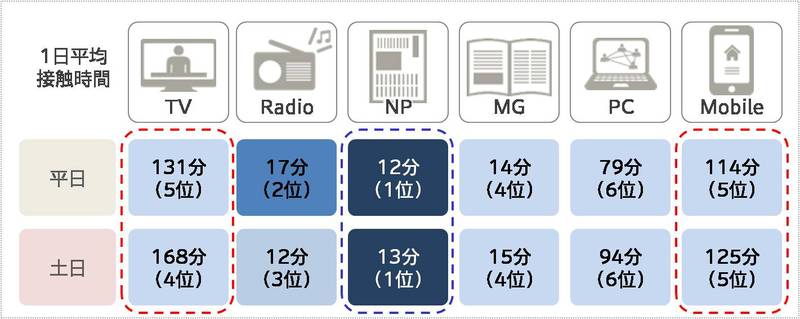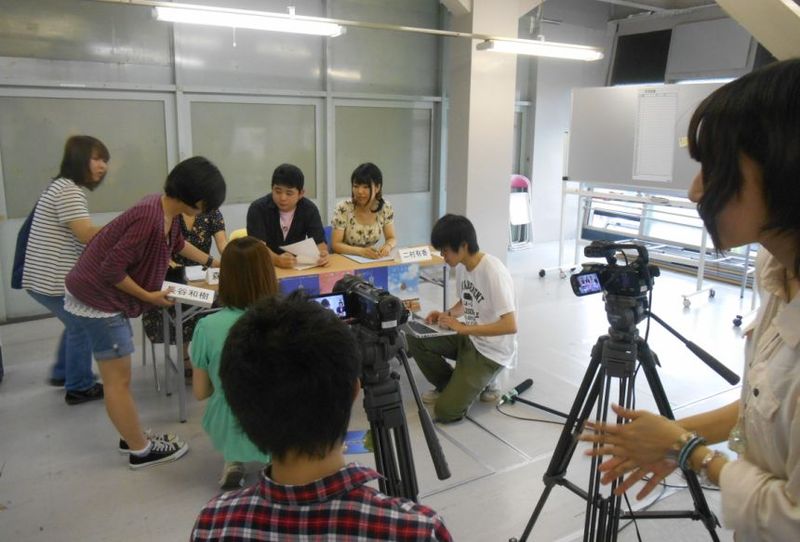
In "Wakamon Data," we previously introduced " Classifying Wakamon Across Japan's 47 Prefectures," categorizing 15-24 year olds nationwide into eight distinct patterns.
This analysis focuses on the Kansai and Chubu regions. Kansai Wakamon's Momoko Okura and Chubu Wakamon's Nanami Takahashi each analyze which patterns are most prevalent in their respective areas.
■Kansai Area Has a High Proportion of "Happy My Life" Types
First, Ōkura analyzes young people in Kansai.
Our cluster analysis revealed a distinctive feature of the Kansai region: the proportion of "Happy My Life" types is higher here (16.3%) compared to the overall average (14.9%).

"Happy My Life" types are highly interested in fashion, beauty, and dieting, and are also tuned into entertainment news. They enjoy lively places, are highly social, and love shopping. They spend a lot of time watching TV and using the internet on their smartphones. They are also active users of social media.

This time, we interviewed "Happy My Life" students in Kansai to explore the reality of Kansai Wakamon.
Kansai Wakamon Prefer Real Communication Over Virtual
The "Happy My Life" group scored higher than other clusters and the overall average on "enjoying lively places" and "being the type to warm up to strangers quickly."

When we asked university students in Osaka, many said they "like spending time in lively, real-life settings, even with people they've just met." Looking at how they use SNS, we found many young people link their SNS use to real-life communication.
One girl explained, "If I see on Facebook or Twitter that a friend is in Umeda, I'll call them right away to meet up. That's why I constantly check Facebook and Twitter." Several boys agreed, suggesting that Kansai Wakamon's SNS use is heavily focused on gathering "where are you now" information to facilitate "meeting up in real life."
Overseas and Kansai-oriented more than Tokyo
A characteristic of "Happy My Life" users is a strong tendency toward being trend-followers, often liking new things, trendy items, or foreign goods.

Looking at Kansai youth through this lens revealed some distinct traits. The Color Run (an event where participants run through a course covered in colorful "color powder") recently held for the first time in Kansai became quite a hot topic among students. When asked how they gather information, a university student who mentioned, "There are a lot of trend-followers around me. Many people jump right on new brands, products, and things they can enjoy with friends," revealed they tend to research overseas events, brands, and products online more than domestic information outside Kansai.
When I mentioned that Tokyo actually held the Color Run event first, they seemed unaware. This revealed a tendency to rarely research information about Tokyo or other domestic areas.
One girl stated, "Rather than what's landed in Tokyo or what's trending there, I gather info on what's hot and trending overseas. Once I know when those things hit Kansai, I invite all my friends! I don't really pay attention to Tokyo stuff (laughs)." A male student agreed, adding, "Looking at my friends, I don't think anyone assumes overseas things land in Tokyo first."
Kansai's trend-conscious youth, the "Happy My Life" crowd, seem to live their lives keeping tabs on overseas and Kansai-related information rather than focusing on Tokyo. (Momoko Okura)
■Central Japan has a high proportion of "Down-to-Earth Local Lovers"
Next, Takahashi analyzes young people in the Chubu region.
A defining characteristic of the Chubu region is the higher proportion of "Down-to-Earth Local Lovers" at 18.5%, compared to the national average of 14.5%.

"Solid Local Lovers" are strongly attached to their hometowns and highly conscious of local politics, administration, and social issues.
They actively participate in local events, festivals, and volunteer activities, value loyalty and human relationships, and are the type to quickly bond with others.
Based on survey data from Dentsu Inc. Youth Research Department (Wakamon) and actual interviews with students in Nagoya, let's explore what kind of young people these "dependable local-loving folks" are.
The reliable local-loving youth of Chubu, working alongside government and businesses to invigorate their hometowns
Comparing the "Responsible Local Lovers" with the overall youth population among the eight youth patterns reveals...

It's clear they not only have affection for their hometown but also take "action" by showing interest in local developments (politics/administration) and participating in local events.
When we asked Nagoya students if they take action for their hometown, one replied: "I participate in the 'Domatsuri' event every year. It's a midsummer tradition where about 700 volunteers join, and student executive committee members coordinate them."
"Domatsuri" is the common name for the "Nippon Domannaka Matsuri" (Japan's Heartland Festival), a dance festival held in midsummer in Nagoya, right in the heart of Japan. Around 200 teams gather from Japan and abroad to perform dances, attracting over 2 million visitors.
At this event, which greatly energizes the city of Nagoya, student executive committee members take charge of creating stage scripts and managing operations every year. It seems students have even handled gathering sponsors in the past.
One student shared, "In winter, for 'Candle Night Nagoya,' we meticulously arranged candles. We designed it so you could read messages when looking down from the top of the TV tower."
Nagoya also hosts the "Nagoya Campus" project, involving students from numerous universities.
Launched by Nagoya City in spring 2012, it's a virtual campus where students engage in extracurricular activities, aiming to create a vibrant city driven by student energy.
Activities include helping organize events to energize Nagoya like "Candle Night," "Student EXPO," and "Nagoya Festival," sharing student opinions via Ustream, and collaborating with the government to boost the local community.
This shows how young people in the Chubu region are successfully leveraging the power of government, businesses, and organizations to invigorate their local communities.
Track trends on Twitter with "Osumitsuki," and check local news in the "Ohizamato" local newspaper
Next, let's examine the media consumption patterns of the "down-to-earth local love" demographic.
Here is a table showing the average daily media contact time.
*The numbers in parentheses indicate their ranking among the 8 youth patterns in terms of contact time.

The most frequently accessed media is television, followed by smartphones. (Red dotted line section)
This trend remains consistent across all 8 youth patterns.
When we actually asked Nagoya students about their media use, one shared: "Sneakers are trendy lately, but I saw on Twitter that my Tokyo friends and celebrities started wearing them first. Three months later, my Nagoya friends started wearing them too. You can see the wave of trends coming just by watching Twitter."
It's interesting that they get this "stamp of approval" information—essentially a Tokyo-branded "It's hot in Tokyo right now!"—in real time from Twitter, and that they even understand the "trend time lag" where the wave arrives later.
Additionally, the "reliable local love" pattern is characterized by longer contact time with "newspapers" compared to other patterns. (Blue dotted line section)
Regarding newspapers, many mentioned, "The Chunichi Shimbun is always at my parents' house."
While contact time is naturally longer for smartphones and PCs, this suggests that for young people in the Chubu region, where many live with their parents, the local newspaper has established a permanent place in their "home turf."
The Chubu region has a higher proportion of "dependable local-loving individuals" compared to other areas.
Looking at the actual situation, it appears they naturally engage in actions like "social contribution" and "boosting the local community" without putting on airs, enjoying themselves in the process.
Furthermore, while they grasp trends "in real time" through social media like Twitter, they understand that actual trends have a "time lag" compared to other regions. This offers insights into the information-seeking behavior of today's young people in regional areas. (Nanami Takahashi)
This analysis compared young people in the Kansai and Chubu regions.
While they are often lumped together as "urban youth" or "regional youth," carefully examining differences by area reveals distinct characteristics.
We at Wakamon will continue to listen closely to the voices of young people in each region.
〈Analysis Overview〉
Factor analysis and cluster analysis were conducted based on Video Research Ltd.'s "J-READ" data.
Dentsu Inc. conducted the analysis independently. Aggregated data covering multiple prefectures was calculated with regional population weighting applied.
Data Used:J-READ (National Newspaper Survey)
Survey Sponsor: Video Research Ltd.
Survey Area: All 47 prefectures
Analysis Target: 4,193 male and female samples aged 15-24 (J-READ total: 28,826 samples aged 15-69)
Survey Period: October 20 (Sun) to October 26 (Sat), 2013
Survey Method: Mail survey using random telephone numbers

【Wakamon Profile】
Dentsu Inc. Youth Research Department (commonly known as Wakamon) is a planning team that engages with the real lives and mindsets of young people, primarily high school and university students. By understanding their "now," we seek hints to brighten and invigorate the near future. We foresee the future based on their insights and realize new businesses that foster better relationships between young people and society. Currently, 14 project members are based across our Tokyo headquarters, Kansai branch, and Chubu branch. Information is also shared on the Wakamon Facebook page.















